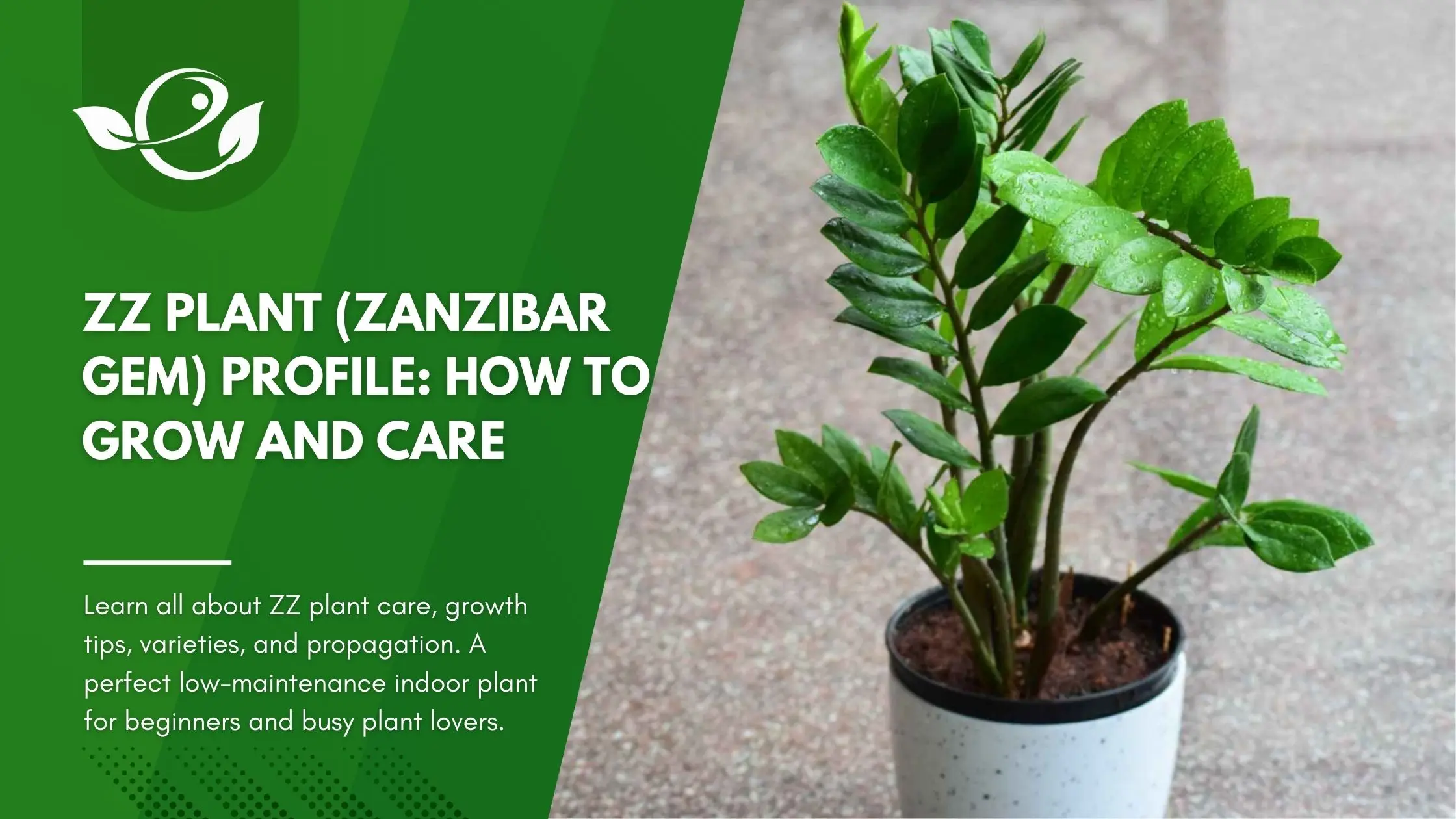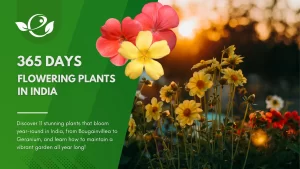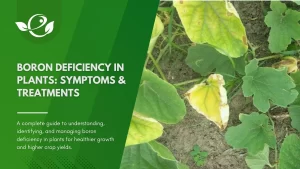Table of Contents
In the realm of indoor greenery, the ZZ plant (Zamioculcas zamiifolia) stands out as a paragon of resilience and elegance. With its glossy, deep green leaves and robust nature, this plant has become a favorite among both novice and seasoned plant enthusiasts. Whether you’re looking to add a touch of verdant beauty to your living space or seeking a low-maintenance companion for your busy lifestyle, the ZZ plant offers the perfect blend of aesthetic appeal and effortless care.
In this comprehensive guide, we explore everything you need to know about growing, caring for, and troubleshooting your ZZ plant while delving into its unique features and history.
Understanding the ZZ Plant
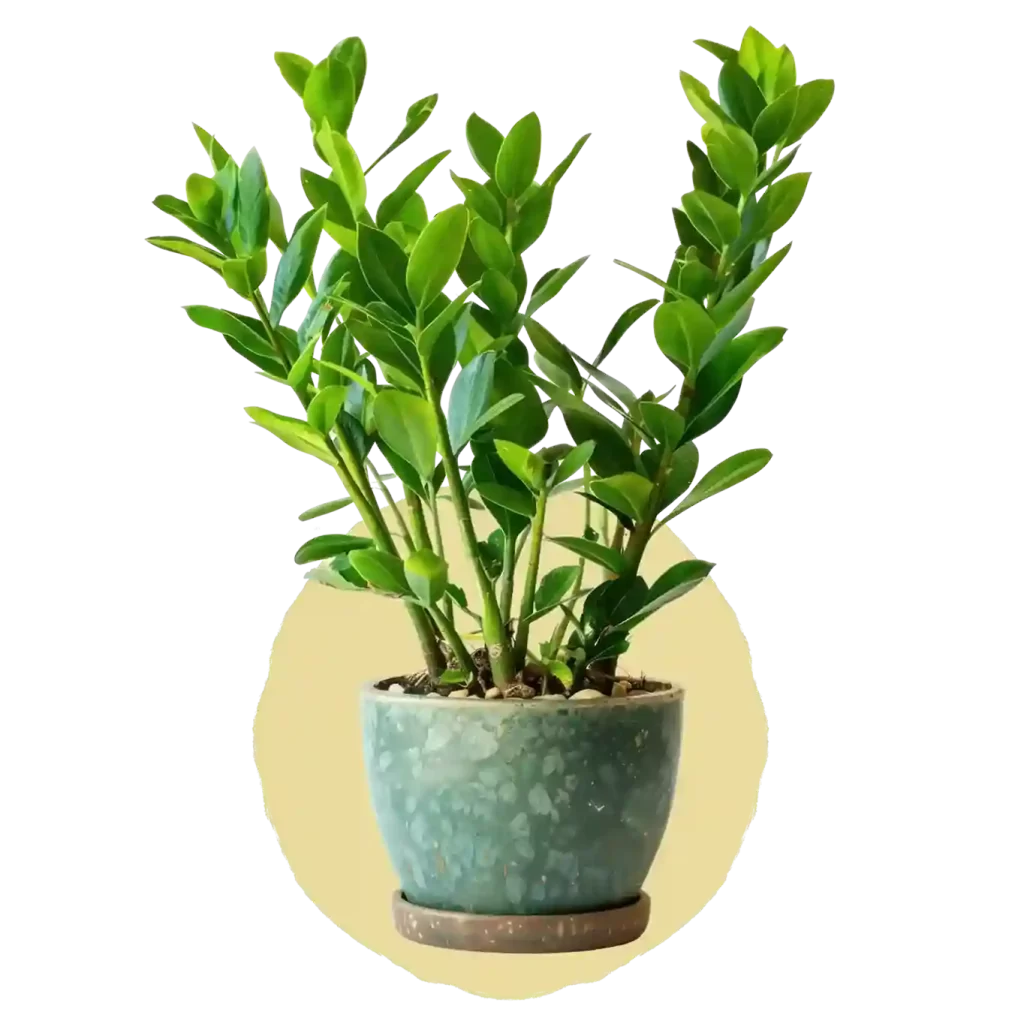
What Is a ZZ Plant?
The ZZ Plant (Zamioculcas zamiifolia) is a tropical perennial native to Eastern Africa. It’s famously known as the Zanzibar Gem, eternity plant, or even the Fortune Tree. With its waxy, oval-shaped leaves that emerge from thick, water-storing rhizomes, this plant exemplifies both beauty and resilience.
History and Origins
Originally thriving in the drought-prone regions of East Africa, the ZZ plant adapted to survive in low-water environments. It wasn’t until the 1990s that ZZ plants entered the global houseplant market. Today, their popularity is largely due to their ability to flourish in low-light conditions and minimal care requirements, making them ideal for modern homes and offices.
| Attribute | Details |
|---|
| Common Name | ZZ Plant, Zanzibar Gem, Eternity Plant |
| Botanical Name | Zamioculcas zamiifolia |
| Plant Type | Tropical Perennial / Houseplant |
| Family | Araceae |
| Hardiness Zones | USDA Zones 9–10 |
| Native Area | Eastern Africa (from Kenya to South Africa) |
| Sun Exposure | Thrives in bright, indirect light to low light; direct sunlight can scorch leaves |
| Soil | Well-draining potting mix (ideal for succulents) |
| Water Needs | Low – water only when the top few inches of soil are dry; drought tolerant due to water-storing rhizomes |
| Toxicity | Toxic to humans, cats, and dogs if ingested; handle with care when pruning |
ZZ Plant varieties
ZZ plants (Zamioculcas zamiifolia) have captured the hearts of houseplant enthusiasts thanks to their striking foliage, low maintenance care, and ability to thrive in a variety of indoor conditions. Over the years, several cultivars have emerged that offer variations in color, size, and texture. Below is an overview of the most popular ZZ plant varieties:
Common Green ZZ Plant
- The classic version of the ZZ plant features solid, glossy, dark green leaves with a naturally vibrant appearance.
- Highlights:
- Extremely hardy and forgiving
- Excellent for low-light environments
- Most readily available and familiar in nurseries
- Similar to all ZZ plants—water sparingly, use well-draining soil, and avoid direct sunlight to keep the leaves shiny and healthy.
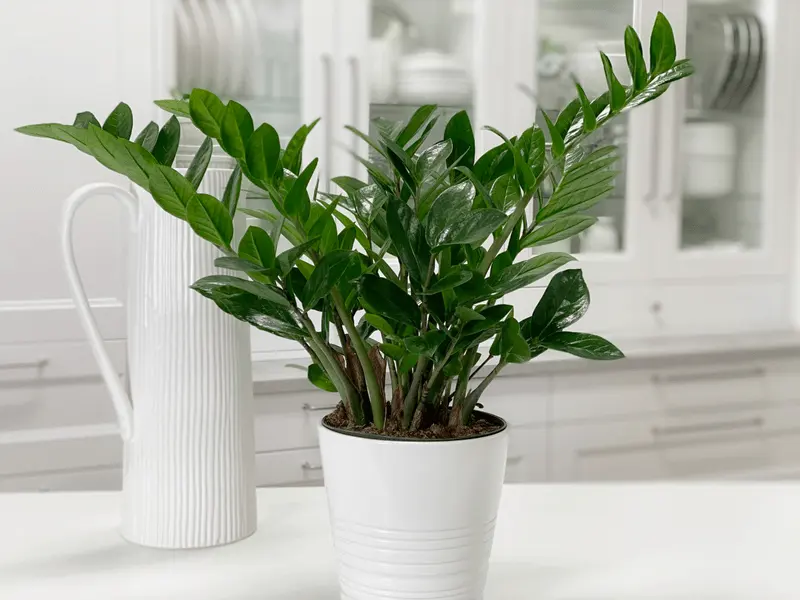
Black Raven ZZ Plant
- Also referred to as the “Raven ZZ,” this variety is distinguished by its striking deep purple to almost black foliage. New growth often emerges as a bright lime green before darkening over time.
- Highlights:
- Dramatic, contrasting coloration provides a bold interior accent
- A unique twist on the conventional green ZZ
- While its care requirements are largely similar to the common ZZ, the Black Raven may show a slight preference for brighter light (indirect) to help maintain its dark pigmentation. Consistent watering and proper drainage remain key.

Variegated ZZ Plant (ZZ Variegata)
- The variegated cultivar showcases leaves that sport splashes or margins of cream, light green, or yellow against the standard dark green background.
- Highlights:
- Offers a more striking and dynamic leaf pattern
- Can serve as a focal point in interior décor
- Variegated ZZ plants might require marginally more light than their all-green counterparts to maintain their coloration. However, they still share the ZZ plant’s overall tolerance for lower light levels and infrequent watering schedules.
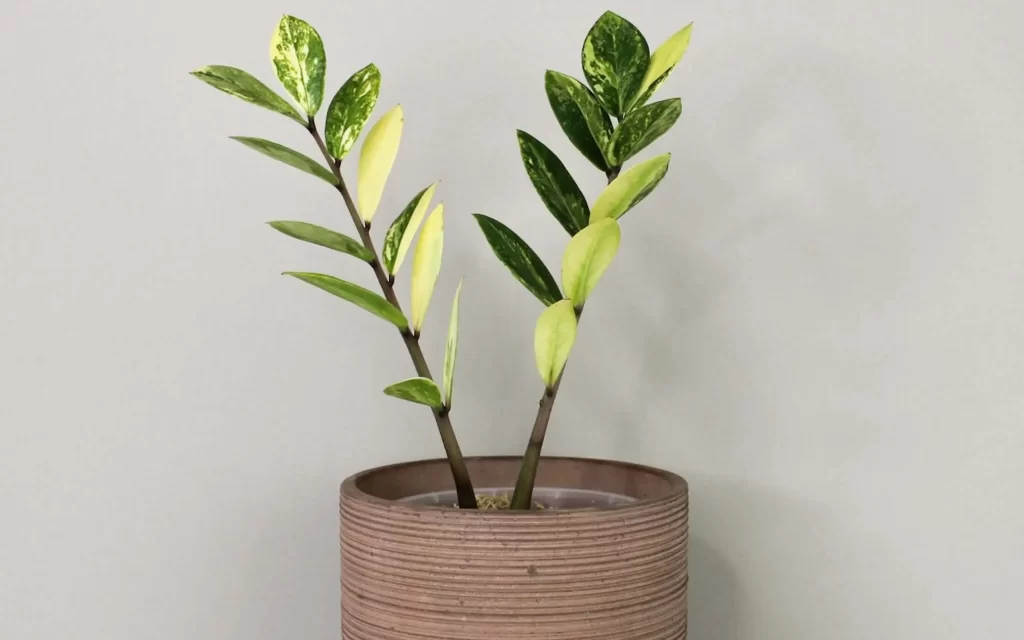
‘Zenzi’ – The Dwarf ZZ Plant
- ‘Zenzi’ is a compact or dwarf version of the ZZ plant, characterized by a denser, more clustered growth habit and a smaller overall size.
- Highlights:
- Ideal for limited spaces or tabletops
- Retains the ZZ plant’s renowned resilience and low-maintenance care
- Like other ZZ varieties, ‘Zenzi’ needs similar conditions, though its smaller size may allow for even less frequent watering and makes it a versatile choice for compact apartments or office desks.
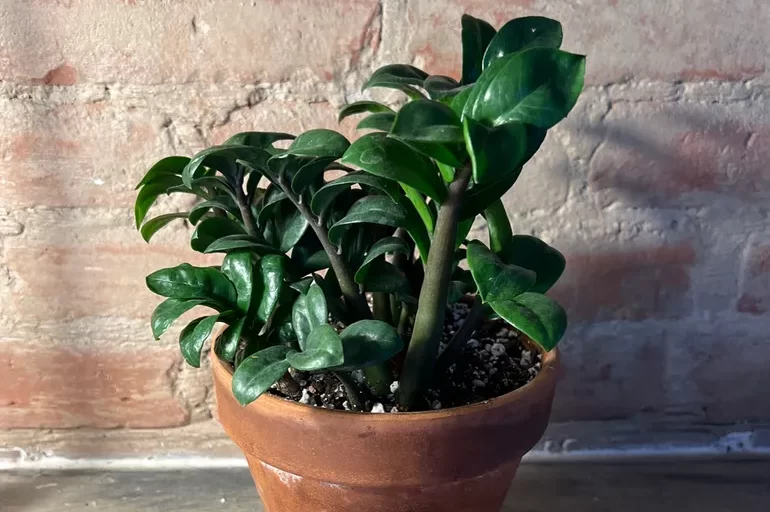
Benefits of the ZZ Plant
ZZ plants are not only celebrated for their striking appearance and effortless care; they also offer an array of practical and holistic benefits that enhance indoor environments. Here’s an in-depth look at what makes the ZZ plant an exceptional choice for your home or office:
- Air Detoxification: Like many indoor plants, the ZZ plant helps improve indoor air quality. It is known to filter common airborne pollutants such as formaldehyde, benzene, and toluene.
- Drought Tolerance: The ZZ plant is particularly well-regarded for its ability to store water in its fleshy rhizomes. This adaptation makes it incredibly forgiving if you occasionally forget to water, making it an ideal choice for people with busy lifestyles or those new to plant care.
- Feng Shui Harmony: In Feng Shui, the ZZ plant is often regarded as a symbol of good fortune and prosperity. Its sturdy nature and persistent growth are believed to foster positive energy and balance in home or office settings.
- Light Tolerance: ZZ plants thrive in low to moderate indirect light. They can prosper in rooms with limited natural light, such as offices or interior rooms.
- Reduction of Stress: Studies have shown that interaction with houseplants can reduce stress levels, boost mood, and even enhance productivity.
ZZ Plant Care: Essential Tips
Maintaining a healthy ZZ plant is all about understanding its natural habitat and mimicking those conditions indoors. The following care tips address the primary areas that influence the plant’s overall well-being.
1. Light Requirements
ZZ plants are native to shady understory environments and thus thrive in low to medium indirect light. They perform well in spaces that receive ambient light from north or east-facing windows. While they can persist in dim conditions (such as offices with only fluorescent lighting), providing brighter, indirect light encourages more robust, even growth. Direct exposure can scorch the waxy leaves, diminishing their glossy texture and causing burn spots. Use sheer curtains or place the plant slightly away from window sills where sunlight is diffused.
- Artificial Lighting: In spaces that lack natural light, high-quality LED grow lights or fluorescent bulbs can supplement the plant’s requirements.
- Positioning: Experiment with placement in different areas of your home to find the spot that offers a balance of light without intensity.
2. Watering Wisely
ZZ plants store water in their rhizomes, so they are naturally drought-tolerant. This allows you to water sparingly without worrying about immediate stress. Before watering, insert your finger or use a moisture meter into the top 2–3 inches of soil. Water only when the soil is completely dry. Overwatering may lead to root rot, which is a common issue with ZZ plants.
- In spring and summer, watering every 2–3 weeks is generally sufficient.
- In fall and winter, reduce the watering frequency to about once a month as the plant enters a slower growth phase.
- Top Watering: Water from above until excess water drains out from the bottom of the pot.
- Bottom Watering: Alternatively, you may allow the plant to sit in a tray of water for 10–15 minutes, ensuring the roots absorb the moisture. Always empty any residual water to prevent soggy conditions.
3. Soil and Fertilization
ZZ plants require a soil mix that drains well to prevent waterlogging. A recommended choice is a commercial indoor potting mix designed for succulents or a blend enriched with perlite or orchid bark. Good aeration is essential. Using a slightly chunky mix can help keep the roots from sitting in moisture, thereby reducing the risk of rot.
- Low Fertilizer Demand: ZZ plants are relatively light feeders, so overfertilizing can harm their delicate root systems.
- Growing Season Feeding: Apply a balanced, water-soluble fertilizer diluted to half strength during the growing season (spring and summer). A monthly application is typically adequate.
- Winter Dormancy: In winter, when growth slows, pause fertilization to avoid nutrient buildup which can lead to salt accumulation in the soil.
- Slow-Release Options: For those who prefer less frequent feeding, incorporating a slow-release fertilizer at repotting can maintain nutrient supply without the risk of overfeeding.
4. Temperature and Humidity
ZZ plants prefer temperatures between 65°F and 75°F. Maintaining indoor temperatures within this range supports optimal metabolism and growth. Exposure to temperatures below 45°F can stress the plant; therefore, avoid placing it near air vents, open windows during winter, or doors that lead outside.
Humidity Considerations:
- Average Humidity Suffices: ZZ plants tolerate average household humidity, making them suitable for most indoor settings.
- Air Circulation: While they do not require high humidity, ensuring good air circulation can help prevent fungal issues. In drier climates or during winter when heating lowers indoor humidity, occasional placement near a humidifier (or grouping with other plants) can be beneficial.
- Leaf Dusting: Keeping the leaves free from dust is not only aesthetically pleasing but also improves their ability to photosynthesize effectively.
5. Pruning
ZZ plants naturally maintain a compact form and seldom require extensive pruning. However, removing damaged or yellowing leaves promotes overall plant health. Regularly inspect your plant for signs of stress, such as browning leaf tips or wilted leaves. Use clean, sharp pruning shears to snip away old, yellow, or damaged leaves at the base of the stem. Avoid over-pruning since these plants have slow growth rates.
Troubleshooting Common ZZ Plant Problems
Leggy Growth
Leggy growth occurs when the plant’s stems stretch out excessively, resulting in elongated internodes and fewer, often smaller, leaves along the stem. This is usually a clear sign that the plant is striving to reach a better light source. When a ZZ plant does not receive enough light, it allocates its energy toward vertical growth instead of producing compact, robust foliage. If the plant is only receiving light from one direction, the side facing away from the light may have sparser growth.
- Diagnostic Clues: Noticeable spacing between leaves with long, thin stems. A tendency for the plant to lean towards the light source.
- Effective Remedies:
- Increase Light Exposure: Gradually move the plant to a brighter area. Bright, indirect light is ideal to balance growth without causing leaf burn.
- Rotate Regularly: Turn the plant periodically to ensure even exposure on all sides, which promotes uniform growth and prevents one-sided stretching.
- Pruning as a Corrective Measure: If leggy growth is extensive, selectively prune the spindly sections. This not only reduces the stretch but can also encourage the development of new shoots from the base.
Yellow Leaves
Yellowing leaves are a common symptom that may indicate several underlying issues. While a few older leaves turning yellow may be normal, widespread yellowing calls for closer inspection. Excess moisture in the soil leads to poor oxygen availability around the roots, which can result in nutrient deficiencies. Insufficient or imbalanced fertilizer application may cause older leaves to yellow prematurely. Although ZZ plants tolerate low light well, sudden exposure to harsh, direct sunlight may bleach and yellow the leaves.
- Diagnostic Clues: Uniform yellowing across multiple leaves rather than isolated spots. Accompanying soft or mushy stems may suggest water-related issues rather than a simple nutrient deficiency.
- Effective Remedies:
- Adjust Watering Practices: Ensure you allow the top inches of soil to dry out completely before watering again. If the soil is consistently wet, consider repotting with a fresh, well-draining mix.
- Evaluate Fertilizer Use: Avoid excessive fertilization. When using a balanced, diluted fertilizer during the growing season, do so sparingly to prevent an overload of nutrients that can disrupt the plant’s natural balance.
- Modulate Light Exposure: Confirm that the plant is not exposed to direct sunlight, particularly during peak hours. A shift to bright indirect light can help restore its natural green hue over time.
Wilting or Droopy Leaves
Wilting or droopy leaves indicate that the plant is experiencing stress. Although ZZ plants are drought tolerant, droopiness should not be ignored. Despite their ability to store water, prolonged drought may leave the plant’s tissues dehydrated, causing them to sag or wrinkle. Conversely, saturated soil may lead to root stress, in which roots struggle to absorb oxygen properly, resulting in droopy leaves. Sudden changes in temperature or drafts can also cause the leaves to lose turgor pressure.
- Diagnostic Clues: Consistently dry soil and wrinkled leaf surfaces indicate underwatering. Limp, waterlogged soil with excessively moist leaves implies overwatering. Rapid drooping following exposure to sudden cold drafts or heat spikes.
- Effective Remedies:
- Soil Moisture Check: Use a moisture meter or simply finger-test the soil to determine whether watering is needed.
- Consistent Watering Routine: Water only when the top few inches of soil are dry, & ensure excess water drains freely out of the pot.
- Stabilize the Environment: Place the plant in a location where temperature fluctuations are minimal and avoid positioning near air vents or drafty windows.
Root Rot
Root rot is a serious condition that affects the plant’s underground systems, leading to the decay of roots and rhizomes. This is often a consequence of prolonged overwatering, and it can significantly impair the plant’s ability to absorb water and nutrients. Waterlogged soil creates an anaerobic environment that is conducive to fungal or bacterial infections. Using a container without proper drainage holes or retaining too much water in the soil can exacerbate the problem.
- Diagnostic Clues: Roots that appear brown, black, or mushy instead of firm and white. An unpleasant, musty odor emanating from the soil. The above-ground portions of the plant may appear wilted or their leaves may turn yellow/brown despite a dry surface.
- Effective Remedies:
- Immediate Isolation: Remove the plant from its pot as soon as root rot is suspected to prevent further damage.
- Trim Affected Roots: Using sterilized scissors or pruning shears, cut away all the decayed roots. Ensure you leave only healthy, firm roots behind.
- Repot in Fresh Soil: Repot the plant in a clean container using a well-draining soil mix formulated for succulents or houseplants.
- Modify Watering Practices: Allow the soil to dry completely between waterings, and improve drainage by checking that the pot has adequate holes.
- Monitor and Adjust: After repotting, continue to observe the plant for signs of recovery. Avoid fertilization until the plant shows clear signs of regrowth to prevent stressing the recovering roots.
Common Pests and Plant Diseases
| Pest/Disease | Common Cause | Signs to Look For |
|---|
| Mealybugs | Poor air circulation, humid conditions, overwatering | Small, white cotton-like masses on stems and leaf axils; sticky residue (honeydew) on foliage |
| Scale Insects | Low airflow, persistent high humidity, lack of pest control | Tiny, hard, rounded or oval bumps on stems and undersides of leaves; may exude a sticky film (honeydew) |
| Fungus Gnats | Overwatering, overly moist potting mix | Small, dark flying insects near the soil surface; larvae (tiny, worm-like) visible in the soil |
| Aphids | Plant stress, crowded conditions | Tiny, soft-bodied insects that cluster along new growth or underside of leaves; sticky residue on foliage |
| Root Rot | Overwatering; poor drainage soil | Yellowing and wilting foliage; mushy, brown, or black rhizomes; unpleasant odor from the soil |
| Leaf Spot (Fungal/Bacterial) | Excess moisture, high humidity, inadequate airflow | Brown or yellow spots on leaves, sometimes with a fuzzy border; progressive discoloration of foliage |
ZZ Plant Safety: Toxicity Considerations
While ZZ plants are celebrated for their hardiness and low care, they do carry safety warnings:
- Placement: Keep your ZZ plant out of reach of pets and young children, or choose pet-safe alternatives if necessary.
- Toxicity: All parts of the ZZ plant contain calcium oxalate crystals, which can irritate the mouth, throat, and stomach if ingested by children or pets.
- Handling: When pruning or repotting, consider wearing gloves to prevent skin irritation.
If you are known to have sensitive skin, preempt any issues by wearing gloves when repotting; ZZ plant sap is known to cause irritation in sensitive individuals.
Repotting ZZ Plants

Generally, repot your ZZ plant every 2–3 years. The best time is during the growing season, typically in spring or early summer.
- Indicators for Repotting:
- Roots emerging from drainage holes.
- Soil drying out more rapidly than usual.
- Visible crowding or deformation of the pot.
- Choosing the Right Pot and Soil: Opt for a pot that is 1–2 inches larger in diameter than the current one. Ensure it has drainage holes to prevent water accumulation, which can lead to root rot. Use a well-draining potting mix, such as one formulated for succulents or cacti. This ensures proper aeration and moisture control.
- Repotting Steps:
- Preparation: Water the plant a day before to minimize stress.
- Removal: Gently tilt the pot and ease the plant out, supporting the base to avoid damage.
- Inspection: Examine the rhizomes and roots. Trim any that are mushy or show signs of rot.
- Placement: Add a layer of fresh soil to the new pot. Position the plant centrally, spreading the roots evenly.
- Filling: Add soil around the plant, pressing lightly to eliminate air pockets. Ensure the rhizomes are just below the soil surface.
- Aftercare: Wait a few days before watering to allow any disturbed roots to heal, reducing the risk of rot.
Propagating ZZ Plant
Propagating ZZ plants can be achieved through several methods:
1. Division
This is the quickest and most reliable method, ideal during repotting.
- Uproot the Plant: Carefully remove the plant from its pot.
- Separate Rhizomes: Gently divide the rhizomes into sections, ensuring each has at least one stem and a healthy root system.
- Repot Divisions: Plant each section into a separate pot with fresh, well-draining soil.
- Aftercare: Water lightly and place in indirect light, allowing the divisions to acclimate.
2. Stem Cuttings
This method allows for multiple new plants but requires patience.
- Select a Healthy Stem: Choose a mature stem and cut a 3–6 inch section using sterilized scissors.
- Water Propagation:
- Place the cutting in a glass of water, ensuring only the bottom is submerged.
- Change the water weekly to prevent bacterial growth.
- Once roots are 1–2 inches long, transplant into soil.
- Soil Propagation:
- Let the cutting dry for a few hours to form a callus.
- Plant the cut end into moist, well-draining soil.
- Keep the soil lightly moist and place the pot in indirect light.
3. Leaf Cuttings
A slower method, but useful for propagating multiple plants.
- Prepare Leaves: Snip healthy leaves with a small portion of the petiole (leaf stem).
- Callusing: Allow the cut ends to dry for a few hours.
- Planting:
- Insert the cut end into moist, well-draining soil, about 1 cm deep.
- Plant multiple leaves in a single pot for better chances of success.
- Aftercare:
- Maintain slight soil moisture.
- Place the pot in a warm area with indirect light.
- Be patient; root and rhizome development can take several months.
Frequently Asked Questions (FAQs)
Is a ZZ Plant Suitable for Beginners?
Yes! The ZZ plant is renowned for its resilience, low watering needs, and adaptability to different lighting conditions, making it one of the best choices for new plant owners.
How Often Should I Water My ZZ Plant?
Water your ZZ plant when the top 2–3 inches of the soil are completely dry. Typically, this means watering every 2–3 weeks during warmer months and reducing frequency in winter.
What Are Common Signs of Overwatering?
Yellowing or droopy leaves, mushy stems, and an overall limp appearance are key indicators of overwatering. In such cases, allow the soil to dry thoroughly and consider repotting if rot has set in.
Conclusion
Embracing the ZZ plant in your indoor garden not only enhances the visual charm of your space but also introduces a steadfast companion that thrives with minimal attention. Its adaptability and striking appearance make it a quintessential choice for those aiming to cultivate a serene and green environment without the complexities of high-maintenance care. As you integrate the ZZ plant into your home, you’ll discover that its enduring beauty and simplicity resonate with the rhythms of everyday life, making it more than just a plant, but a lasting element of your personal sanctuary.
